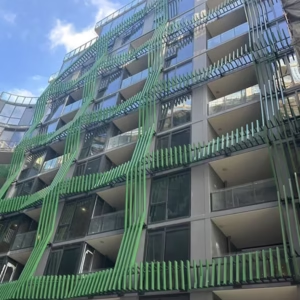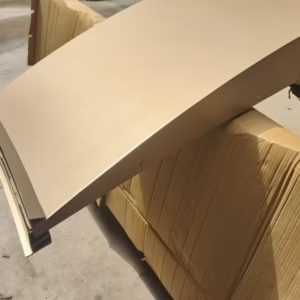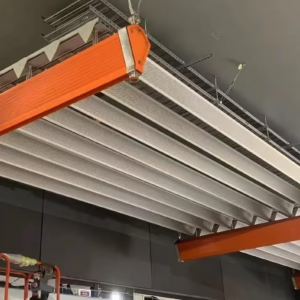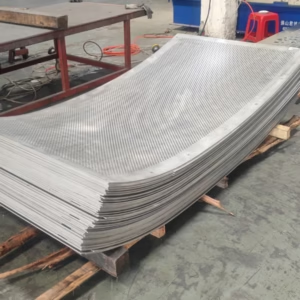Processo di Manutenzione e Sostituzione delle Pareti a Pannelli Compositi di Alluminio: Garantire Sicurezza e Durata
Introduzione alle Pareti a Pannelli Compositi di Alluminio Le pareti a pannelli compositi di alluminio (ACP) sono diventate un pilastro dell'architettura moderna, apprezzate per la loro versatilità estetica, efficienza energetica e proprietà ecocompatibili. Questi sistemi leggeri e durevoli migliorano l'esterno degli edifici contribuendo all'isolamento termico e alla riduzione dell'impatto ambientale. Tuttavia, l'esposizione prolungata alle intemperie, all'inquinamento e all'invecchiamento naturale può compromettere nel tempo la loro integrità strutturale e l'aspetto visivo.

Perché la Manutenzione e la Sostituzione sono Importanti La manutenzione regolare e la sostituzione tempestiva delle pareti a pannelli ACP sono fondamentali per salvaguardare gli edifici. Trascurare usura e danni rischia infiltrazioni d'acqua, allentamento dei pannelli, corrosione e potenziali rischi per la sicurezza. Un intervento proattivo preserva la funzionalità della struttura, previene riparazioni costose e mantiene il fascino architettonico.
Passaggi Chiave nel Processo di Manutenzione e Sostituzione delle Pareti a Pannelli Compositi di Alluminio
Ispezione Iniziale e Valutazione dei Danni Il processo inizia con un'ispezione accurata per identificare problemi come pannelli crepati, rivestimenti sbiaditi, fallimento del sigillante o corrosione del telaio. Strumenti avanzati come droni o imaging termico possono rilevare umidità nascosta o spazi vuoti nell'isolamento.

Preparazione alla Sicurezza e Pianificazione dell'Accesso Vengono stabiliti protocolli di sicurezza, inclusi ponteggi, imbracature e barriere perimetrali. I programmi di lavoro sono ottimizzati per minimizzare le interruzioni agli occupanti dell'edificio.
Rimozione dei Pannelli Danneggiati I pannelli danneggiati vengono rimossi con cura per evitare di danneggiare le sezioni adiacenti. Le viti, i sigillanti e i componenti del sottofondo vengono ispezionati per riutilizzo o sostituzione.
Riparazione del Sottofondo e Preparazione delle Superfici I sottofondi corrosi o indeboliti vengono rinforzati o sostituiti. Le superfici vengono pulite, trattate contro la ruggine e primerizzate per garantire un'adesione ottimale dei nuovi pannelli.
Installazione di Nuovi Pannelli Compositi di Alluminio I pannelli tagliati su misura secondo le specifiche originali vengono fissati utilizzando viti resistenti alla corrosione. Sigillanti ad alte prestazioni vengono applicati alle giunzioni per prevenire infiltrazioni d'acqua e perdite d'aria.
Test di Qualità e Finitura Estetica Controlli post-installazione verificano l'impermeabilità, l'allineamento e la stabilità strutturale. Vengono applicati rivestimenti o finiture per ripristinare l'uniformità visiva e la resistenza ai raggi UV.
Pianificazione della Manutenzione Preventiva Si consiglia un programma di manutenzione a lungo termine, che includa pulizie periodiche, riapplicazione del sigillante e ispezioni delle viti per prolungare la durata della parete a pannelli.
Pre-Valutazione nel Processo di Manutenzione e Sostituzione della Parete a Vetro a Pannelli Compositi in Alluminio: Garantire Precisione e Sicurezza
Ispezione e Test Completi Una pre-valutazione approfondita è la base di un processo di manutenzione e sostituzione efficace della parete a vetro a pannelli compositi in alluminio (ACP). Questa fase identifica i problemi esistenti, determina l'urgenza delle riparazioni e guida le decisioni per soluzioni a lungo termine.

Ispezione Visiva I tecnici iniziano esaminando la superficie esterna dei pannelli ACP per danni visibili come graffi, delaminazione del rivestimento, scolorimento o ossidazione. Questi difetti non solo compromettono l'estetica, ma possono indicare un degrado più profondo del materiale.
Controlli di Integrità Strutturale Le viti, le staffe e le sotto-strutture vengono ispezionate per verificare allentamenti, corrosione o deformazioni. Segni di invecchiamento come giunti indeboliti o pannelli deformati vengono documentati, poiché compromettono la capacità portante della parete e la resistenza alle intemperie.
Test Non Distruttivi Avanzati (NDT) Strumenti come termografia a infrarossi e scanner ultrasonici vengono utilizzati per rilevare difetti nascosti. L'infrarossi identifica trappole di umidità o spazi di isolamento, mentre i test ultrasonici rivelano crepe interne o guasti di bonding all'interno dei pannelli.
Documentazione dei Dati e Analisi della Causa Radice
Mappatura Dettagliata dei Problemi Tutti i problemi identificati — come punti di perdita d'acqua, guasti alle viti o deformità dei pannelli — vengono catalogati con foto, misurazioni e tag di posizione. Questo crea una mappa visiva dei danni per un'azione mirata.
Indagine sulla Causa Radice I dati vengono analizzati per determinare se i guasti derivano da errori di installazione (ad esempio, sigillatura impropria), fattori ambientali (esposizione ai raggi UV, inquinamento) o difetti del materiale (rivestimenti o strati di core di qualità inferiore).

Valutazione del Rischio e Pianificazione Strategica
Valutazione del Rischio di Sicurezza e Operativo Pericoli come detriti cadenti da pannelli allentati o rischi elettrici vicino a telai corrosi vengono prioritizzati. Le sfide specifiche del sito — come lavorare in altezza o intorno a spazi occupati — vengono considerate nei protocolli di sicurezza.
Sviluppo del Budget e del Cronogramma I costi vengono calcolati in base alle proporzioni di sostituzione dei pannelli, all'intensità del lavoro e alla provenienza dei materiali. Viene creato un cronogramma a fasi, bilanciando l'urgenza (ad esempio, perdite immediate) con le esigenze a lungo termine (aggiornamenti di sezioni complete). La allocazione delle risorse include noleggio di attrezzature, piani di smaltimento dei rifiuti e misure di contingenza per ritardi meteorologici.
Allineamento con il Processo di Manutenzione e Sostituzione della Parete a Vetro a Pannelli Compositi in Alluminio Questa fase di pre-valutazione informa direttamente se sono necessari riparazioni localizzate o sostituzioni su larga scala. Ad esempio, una corrosione diffusa del sottocarro può richiedere una revisione completa, mentre danni isolati ai pannelli potrebbero essere risolti tramite riparazioni puntuali. I risultati guidano anche la scelta dei materiali—optando per rivestimenti più resistenti ai raggi UV o nuclei con classificazione antincendio se i precedenti guasti erano legati a stress ambientali.
Integrando queste valutazioni nel processo di manutenzione e sostituzione delle pareti a pannelli compositi di alluminio, gli stakeholder minimizzano le ipotesi, riducono i costi e garantiscono la conformità alle norme edilizie internazionali. Questo approccio proattivo trasforma le riparazioni reattive in soluzioni sostenibili, prolungando la durata della struttura e preservandone l'integrità funzionale e visiva.
Fase di preparazione nel processo di manutenzione e sostituzione delle pareti a pannelli compositi di alluminio
Preparazione dei materiali: garantire coerenza e qualità Un passaggio critico nel processo di manutenzione e sostituzione delle pareti a pannelli compositi di alluminio è la selezione di materiali che corrispondano alle specifiche originali. Vengono scelti pannelli compositi di alluminio (ACP) di alta qualità per replicare il colore, lo spessore, la finitura e le classificazioni di resistenza al fuoco del sistema esistente. I fornitori devono verificare la coerenza del lotto per evitare discrepanze nella texture o nel livello di lucentezza, che potrebbero disturbare l'armonia visiva. Collanti, sigillanti e fissaggi sono anche acquistati per rispettare o superare gli standard del settore, garantendo durabilità a lungo termine contro le intemperie e lo stress strutturale.

Prontezza degli strumenti e delle attrezzature
Strumenti standard Strumenti di base come cacciaviti, trapani, chiavi dinamometriche e attrezzature di sollevamento (ad esempio gru o gondole) vengono ispezionati per la funzionalità. Sono mantenuti strumenti di riserva sul sito per evitare ritardi causati da guasti alle attrezzature.
Macchinari specializzati Piattaforme di lavoro elevato, sistemi di ponteggi e dispositivi di protezione contro le cadute (imbracature, parapetti) vengono sottoposti a controlli di sicurezza rigorosi. I test assicurano che macchinari come elevatori idraulici funzionino senza problemi in altezza, mentre gli strumenti di taglio per la personalizzazione dei pannelli sono calibrati per la precisione.
Assemblaggio del team e formazione
Selezione di personale qualificato Si privilegiano tecnici esperti familiari con il processo di manutenzione e sostituzione delle pareti a pannelli compositi di alluminio. I team includono tipicamente installatori, saldatori, ispettori e supervisori della sicurezza per coprire tutti gli aspetti del progetto.
Formazione completa Le squadre ricevono briefing specifici sui compiti che coprono:
- Protocolli di sicurezza per il lavoro in quota e la gestione di pannelli pesanti.
- Competenze tecniche, come tecniche di sigillatura corrette o impostazioni di coppia dei fissaggi.
- Esercitazioni di risposta alle emergenze per scenari come improvvisi cambiamenti meteorologici o malfunzionamenti delle attrezzature.

Impostazione del sito e coordinamento della sicurezza
Demarcazione della zona di lavoro L'area di costruzione è chiaramente delimitata da barriere, segnali di avvertimento e restrizioni di accesso per proteggere gli occupanti e i pedoni. Coperture temporanee possono proteggere le sezioni adiacenti da polvere o detriti durante la rimozione dei pannelli.
Pianificazione Logistica
- Stoccaggio Materiali: I pannelli e gli strumenti sono conservati in aree designate asciutte e sicure per prevenire danni o furti.
- Gestione dei Rifiuti: Contenitori per il riciclo di vecchi pannelli e contenitori per rifiuti pericolosi per residui di sigillante sono posizionati per uno smaltimento efficiente.
- Protocolli di Emergenza: Percorsi di evacuazione, stazioni di primo soccorso e canali di comunicazione sono stabiliti per affrontare rapidamente gli incidenti.
Allineamento con il Processo di Manutenzione e Sostituzione della Parete a Vetro a Pannelli Compositi in Alluminio Una preparazione accurata riduce al minimo i tempi di inattività e gli errori durante l'esecuzione. Ad esempio, abbinare i colori dei pannelli in anticipo evita costose rifaciture, mentre squadre addestrate riducono il rischio di installazioni improprie che potrebbero causare perdite d'acqua o distacco dei pannelli. La pianificazione del sito incentrata sulla sicurezza non solo rispetta le normative come OSHA, ma favorisce anche la fiducia tra gli occupanti dell'edificio.

Affrontando meticolosamente la qualità dei materiali, l'affidabilità delle attrezzature, la competenza del team e la sicurezza del sito, questa fase getta le basi per un processo di manutenzione e sostituzione della parete a pannelli di alluminio composito senza intoppi. Trasforma piani teorici in passaggi concreti, garantendo che il progetto rimanga nei tempi, nel budget e in linea con i requisiti funzionali ed estetici della struttura.
Esecuzione Passo-Passo nel Processo di Manutenzione e Sostituzione della Parete a Pannelli di Alluminio Composito
1. Rimozione dei Pannelli Danneggiati
Il processo di manutenzione e sostituzione della parete a pannelli di alluminio composito inizia con la rimozione sistematica dei pannelli compromessi. Viene sviluppato un piano di rimozione di precisione per proteggere i pannelli adiacenti e le strutture sottostanti. Gli tecnici utilizzano strumenti non distruttivi per scollegare le viti, minimizzando vibrazioni o pressioni che potrebbero causare danni collaterali. I pannelli rimossi e le attrezzature vengono smistati per il riciclo o lo smaltimento, rispettando le normative ambientali. Reti di sicurezza o sistemi di cattura dei detriti sono installati per prevenire cadute di materiali durante questa fase.
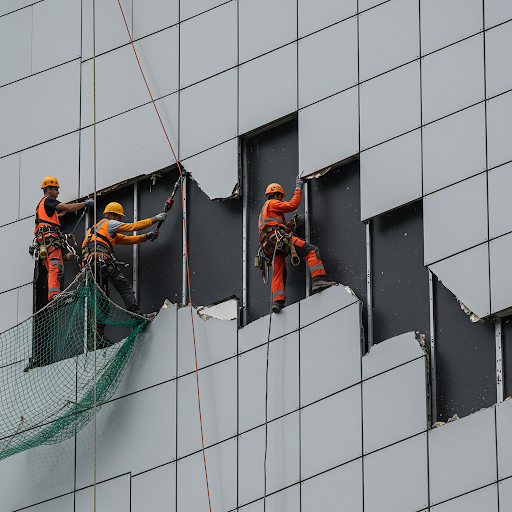
2. Installazione dei Pannelli di Sostituzione
Verifica dei Materiali I nuovi pannelli di alluminio composito (ACP) vengono sottoposti a rigorosi controlli di qualità. Le dimensioni, la coerenza del colore, l'integrità del rivestimento e le classificazioni antincendio sono validate rispetto alle specifiche originali per garantire un'integrazione senza soluzione di continuità.
Posizionamento di Precisione Strumenti di allineamento laser-guidati e sollevatori a vuoto posizionano con precisione i pannelli di sostituzione. Supporti temporanei o morsetti tengono i pannelli in posizione mentre si effettuano micro-regolazioni per un allineamento perfetto con le sezioni vicine.
Fissaggio Sicuro Viti resistenti alla corrosione (ad esempio, viti o rivetti in acciaio inossidabile) sono installate a intervalli pre-progettati. Sigillanti strutturali ad alte prestazioni sono applicati ai bordi dei pannelli, seguiti da compressione per creare legami ermetici e resistenti all'acqua.
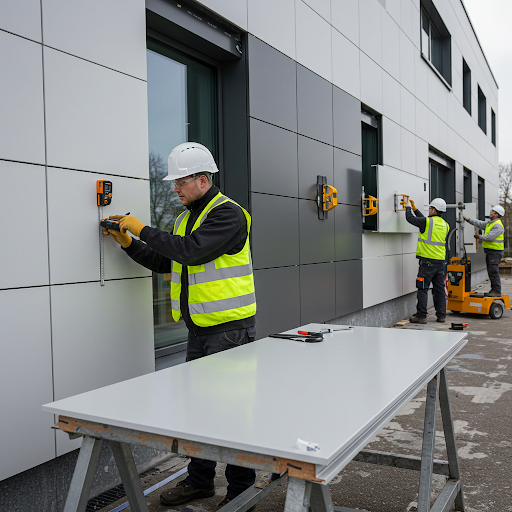
3. Sigillatura di giunti e cuciture
Giunti critici, angoli e intersezioni di pannelli ricevono un'attenzione specializzata. Le superfici vengono pulite, primerizzate e rivestite con sigillanti in poliuretano o silicone di alta qualità. Si possono inserire aste di supporto in gap ampi per ottimizzare l'adesione e la flessibilità. Per geometrie curve o complesse, vengono utilizzati sigillanti formulati su misura per adattarsi all'espansione termica e ai movimenti.
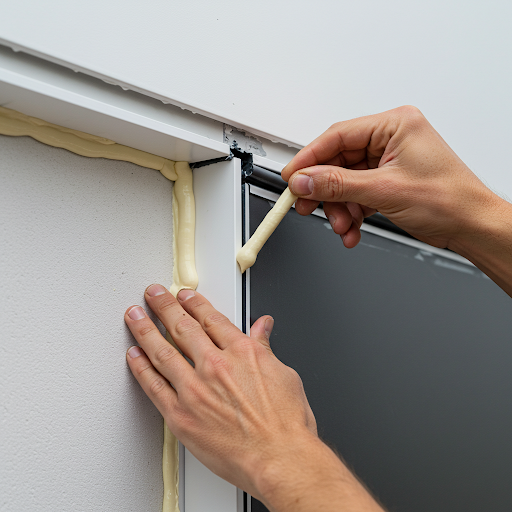
4. Test di Controllo Qualità sul Posto
Ispezione Visiva e Strutturale Le squadre di QA effettuano una revisione post-installazione, verificando:
- Allineamento dei pannelli, uniformità di livello e colore.
- Valori corretti di coppia delle viti utilizzando strumenti calibrati.
- Linee di sigillante lisce e continue senza bolle o spazi vuoti.
Validazione delle Prestazioni
- Test di Penetrazione dell'Acqua: La spruzzatura controllata di acqua valuta l'efficacia dello scarico e della tenuta.
- Test di Infiltrazione d'Aria: Le porte ventilate o le matite di fumo rilevano perdite nel sistema di facciata a pannelli.
- Test di Carico: Test di stress non invasivi verificano la stabilità dei pannelli sotto simulazioni di vento o sismiche.
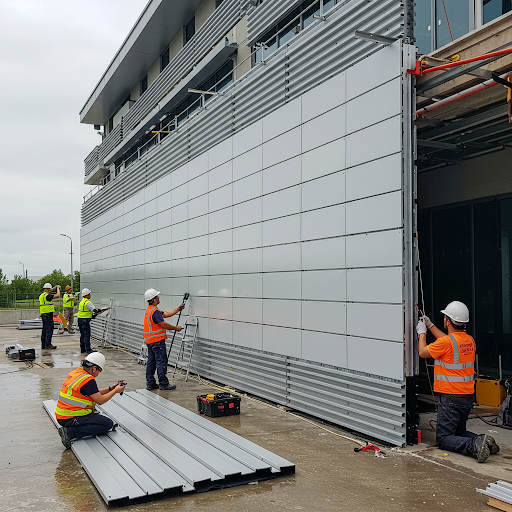
Integrazione con il Processo di Manutenzione e Sostituzione della Facciata a Pannelli in Alluminio Composito Ogni fase è documentata con foto, risultati dei test e certificati di conformità. Ad esempio, i tempi di indurimento del sigillante vengono monitorati per evitare esposizioni premature alla pioggia, mentre i registri di coppia delle viti garantiscono la coerenza. Eventuali deviazioni vengono affrontate immediatamente—come il ritappamento di un giunto o la sostituzione di un pannello mal allineato—per prevenire problemi di prestazioni a lungo termine.
Questa fase trasforma il lavoro preparatorio in risultati tangibili, bilanciando precisione tecnica ed esecuzione pratica. Seguendo il processo di manutenzione e sostituzione della facciata a pannelli in alluminio, i team ottengono riparazioni durevoli che ripristinano la resistenza strutturale, la protezione dagli agenti atmosferici e la continuità visiva. L'approccio sistematico minimizza le interruzioni operative, garantendo che l'edificio rimanga sicuro e funzionale durante tutto il ciclo di vita del progetto.
Guida Completa al Processo di Riparazione e Sostituzione della Facciata a Pannelli in Alluminio
Una corretta manutenzione e riparazioni tempestive sono fondamentali per garantire la longevità e le prestazioni dei sistemi di facciata a pannelli in alluminio. Questa guida illustra le pratiche essenziali per preservare queste strutture, con un focus sul processo di riparazione e sostituzione della facciata a pannelli in alluminio.
Cura e Manutenzione Post-Installazione Ispezioni regolari e pulizie costituiscono la base di una manutenzione efficace delle facciate continue in alluminio.
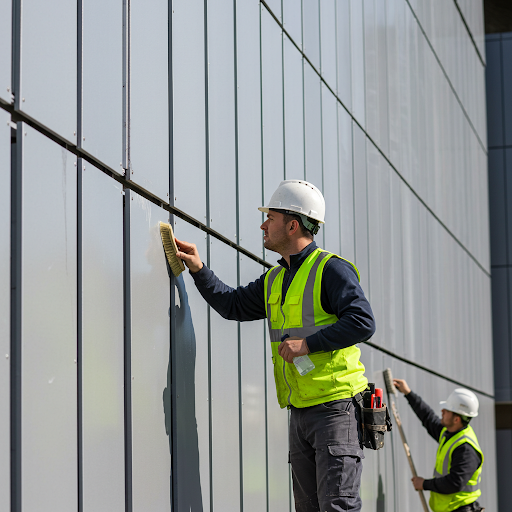
a. Ispezioni e Pulizie Programmate
- Stabilire un piano di ispezione di routine (biennale o trimestrale) per valutare i pannelli per ammaccature, corrosione o usura del rivestimento.
- Pulire le superfici utilizzando detergenti a pH neutro e strumenti a setole morbide per evitare graffi sulle finiture.
- Rimuovere detriti da giunti e canali di drenaggio per prevenire l'accumulo di acqua.
b. Monitoraggio Proattivo Durante il processo di riparazione e sostituzione della facciata continua in pannelli di alluminio, dare priorità alla rilevazione precoce di problemi come fissaggi allentati o pannelli disallineati. Controllare le guarnizioni e le guarnizioni di tenuta per deterioramento, soprattutto dopo eventi meteorologici estremi.
2. Sistemi di Documentazione e Feedback Registri accurati e comunicazioni reattive semplificano i flussi di lavoro di manutenzione.
a. Registrazione Dettagliata Documentare tutte le ispezioni, i risultati dei test (ad esempio, resistenza all'acqua, prestazioni al carico del vento) e le azioni di riparazione. Archiviare foto e note di ogni fase del processo di riparazione e sostituzione della facciata continua in pannelli di alluminio per riferimenti futuri.
b. Integrazione del Feedback Creare canali aperti per appaltatori, ingegneri e responsabili degli edifici per segnalare problemi ricorrenti. Utilizzare i dati per perfezionare i programmi di manutenzione o modificare i materiali per una maggiore durabilità.
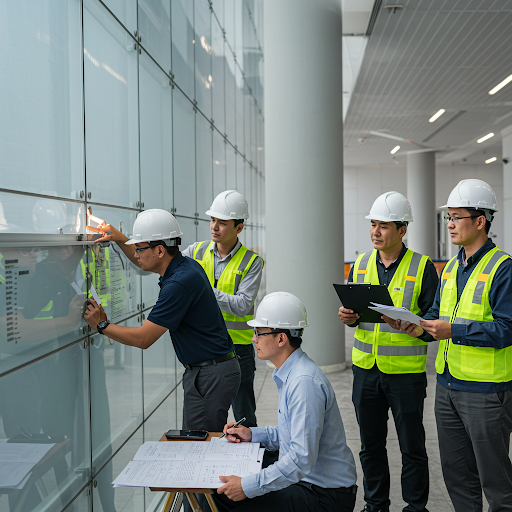
3. Strategie di Manutenzione Preventiva Prevedere e affrontare le vulnerabilità per minimizzare riparazioni costose.

a. Protezione delle Superfici Applicare rivestimenti di ritocco o verniciature localizzate su aree esposte a radiazioni UV o inquinamento. Durante il processo di riparazione e sostituzione della facciata continua in pannelli di alluminio, dare priorità a primer e vernici di alta qualità per prolungare la durata del servizio.
b. Gestione dei Sigillanti Ispezionare annualmente i sigillanti in silicone o poliuretano per crepe, indurimento o perdita di adesione. Sostituire prontamente i sigillanti deteriorati per mantenere l'efficienza termica e l'impermeabilizzazione.
c. Rinforzo strutturale Rinforzare le staffe di supporto o i componenti della struttura nelle zone ad alta tensione. Programmare valutazioni professionali ogni 5–7 anni per valutare l'integrità del sistema.
Passaggi chiave nel processo di riparazione e sostituzione della parete a pannelli in alluminio
- Valutazione dei danni: Identificare pannelli compromessi, elementi di fissaggio o guarnizioni.
- Rimozione sicura: Utilizzare strumenti specializzati per staccare i pannelli danneggiati senza influire sulle unità adiacenti.
- Preparazione: Pulire le superfici del substrato e applicare inibitori di corrosione se necessario.
- Installazione: Fissare i nuovi pannelli con staffe allineate con precisione e tecniche di sigillatura aggiornate.
- Controllo qualità: Verificare l'allineamento, la stagionatura del sigillante e le prestazioni complessive del sistema.
Integrando manutenzione regolare con un processo strutturato di riparazione e sostituzione della parete a pannelli in alluminio, i proprietari degli edifici possono ottimizzare sicurezza, estetica ed efficienza energetica. Collaborare con professionisti certificati per garantire conformità agli standard del settore e alle linee guida del produttore.
Problemi comuni e soluzioni nel processo di riparazione e sostituzione della parete a pannelli in alluminio
Mantenere le pareti a pannelli in alluminio richiede di affrontare sfide ricorrenti per prevenire guasti del sistema. Di seguito, esploriamo problemi frequenti, soluzioni di emergenza ed esempi reali legati al processo di riparazione e sostituzione della parete a pannelli in alluminio.
1. Analisi dei guasti comuni Comprendere le cause profonde aiuta a semplificare le riparazioni e a prolungare la durata della parete a tendina.
a. Graffi superficiali, ossidazione o distacco del rivestimento
- Cause: Abrasione da detriti, esposizione ai raggi UV o metodi di pulizia impropri.
- Soluzioni:
- Per graffi minori: lucida le zone interessate usando composti non abrasivi.
- Affronta l'ossidazione levigando e riapplicando rivestimenti antiruggine.
- Sostituisci i pannelli con distacco grave del rivestimento durante il processo di riparazione e sostituzione della facciata a pannelli in alluminio.
b. Fissaggi allentati e guasto del sigillante
- Cause: Espansione termica, vibrazione o invecchiamento dei materiali.
- Soluzioni:
- Stringi o sostituisci immediatamente viti, bulloni o ancoraggi allentati.
- Rimuovi i sigillanti degradati e riapplica alternative ad alte prestazioni (ad esempio silicone o poliuretano).
2. Misure di risposta di emergenza Agisci rapidamente per mitigare i rischi e ridurre al minimo i tempi di inattività.
a. Soluzioni di riparazione rapide
- Pulizia localizzata e riaffilatura:
- Pulisci le aree danneggiate con solventi a base di alcol per rimuovere contaminanti.
- Inietta nuovo sigillante nelle fessure, assicurando un'adesione completa durante il processo di riparazione e sostituzione della facciata a pannelli in alluminio.
- Rinforzo dei fissaggi:
- Installa supporti secondari o supporti adesivi per stabilità temporanea.
b. Sviluppo di protocolli di emergenza Crea un piano di risposta passo-passo per scenari come distacco del pannello o perdita d'acqua. Forma i team di manutenzione a dare priorità alla sicurezza (ad esempio delimitando le zone pericolose) e all'uso di strumenti specializzati.
3. Studi di caso Impara dalle applicazioni pratiche del processo di riparazione e sostituzione della facciata a pannelli in alluminio.
a. Esempio di Riparazione di Successo
- Problema: Un edificio uffici di 10 anni ha affrontato frequenti infiltrazioni d'acqua a causa di sigillanti crepati.
- Soluzione:
- Selezionati sigilli difettosi utilizzando imaging termico e misuratori di umidità.
- Eseguito il processo di riparazione e sostituzione della parete a pannelli di alluminio: rimosso 15 pannelli danneggiati, aggiornati i sigillanti a varianti resistenti alle intemperie e reinstallate le unità.
- Risultato: Eliminati le perdite e ridotti i costi energetici del 12% grazie a un miglioramento dell'isolamento.
b. Lezioni da un progetto fallito
- Problema: Un intervento di riparazione affrettato ha utilizzato fissaggi di bassa qualità, causando disallineamenti dei pannelli entro 6 mesi.
- Causa principale: Salto delle valutazioni strutturali durante il processo di riparazione e sostituzione della parete a pannelli di alluminio.
- Miglioramenti:
- Implementare controlli strutturali obbligatori prima delle riparazioni.
- Fonte di materiali certificati conformi ai codici edilizi locali.
Principali insegnamenti per il processo di riparazione e sostituzione della parete a pannelli di alluminio
- Diagnostica preventiva: Ispezioni regolari riducono le riparazioni di emergenza.
- Qualità dei materiali: Mai compromettere sigillanti, rivestimenti o fissaggi.
- Formazione e conformità: Garantire che i team seguano protocolli standardizzati e linee guida di sicurezza.
Affrontando sistematicamente i difetti comuni e perfezionando il processo di riparazione e sostituzione della parete cortina in pannelli di alluminio, gli operatori edilizi possono migliorare la durabilità, l'estetica e l'efficienza dei costi. Collaborare sempre con appaltatori accreditati per garantire precisione e conformità alle normative.

